A-frame building
An A-frame house or other A-frame building is an architectural house or building style[1] featuring steeply-angled sides (roofline) that usually begin at or near the foundation line, and meet at the top in the shape of the letter A. An A-frame ceiling can be open to the top rafters.
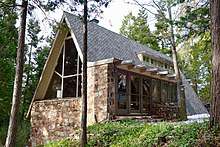
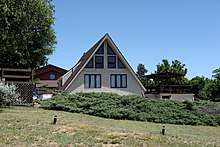
%2C_Santana%2C_Madeira%2C_Portugal.jpg)
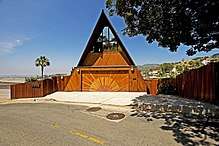
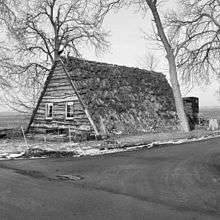
Although the triangle shape of the A-frame has been present throughout history, it surged in popularity around the world from roughly the mid-1950s through the 1970s. It was during the post–World War II era that the A-frame acquired its most defining characteristics.
Style
A-frame buildings are an old form known in Europe, China, and the South Pacific islands sometimes called a roof hut and were simple structures used for utilitarian purposes until the 1950s.[2] In 1934, R.M. Schindler built the first modern A-frame house, for owner Gisela Bennati, in Lake Arrowhead, California.[3] Architects Walter Reemelin, John Campbell, George Rockrise, Henrik H Bull, and Andrew Geller helped to popularize Schindler's idea in the early 1950s, designing A-frame vacation homes.[2] In 1955, Andrew Geller built an A-frame house on the beach in Long Island, New York, known as the Elizabeth Reese House.[2] Geller's design won international attention when it was featured in The New York Times on May 5, 1957.[4] Before long, thousands of A-frame homes were being built around the world.
The Abbey Resort in Fontana-on-Geneva Lake, Wisconsin claims to have the world's tallest wooden A-frame.
Rise in popularity
The post–World War II popularity of the A-frame has been attributed to a combination of factors including Americans' extra disposable income, the inexpensiveness of building an A-frame structure, and a new interest in acquiring a second home for vacationing.[2]
Another factor contributing to the rise of the A-frame included the adaptability of the structure itself, which enabled architects to experiment with more modern designs. A-frames were a useful medium in which architects could explore their creative side since they were relatively cheap to build.
Additionally, many people preferred the idea of a "modern-style" vacation home to that of a "modern-style" primary home. A-frames became available as prefabricated kits, lowering the cost even more, and were sold by Macy's department stores.
After the rise of the archetypal A-frame, architects soon began experimenting with new designs, which led to what became known as the modified A-frame style.
Residential examples
- Bennati House (1934), Lake Arrowhead, California, designed by Rudolph Schindler
- Numerous examples in Washington state.[5]
- Numerous examples, including historic kits and (recent?) "Yosemite-adjacent" ones, in Curbed[6]
- 12 A-frame houses in Northcrest Historic District, Atlanta, Georgia[7]
- Ranger cabin, Oregon, in Zig-zag Ranger District[8]
- Park City, Utah ski houses (two being demolished, but do others survive?)[9]
Churches
- Simpson Methodist Church (1957), Pullman, Washington[5]
- Saint Joseph Church (c.1960), Lynden, Washington[5]
- Yaddlethorpe Methodist Church, Yaddlethorpe? (see File:Yaddlethorpe Methodist Church - geograph.org.uk - 181813.jpg)
Commercial examples
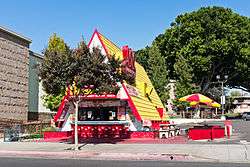
- Numerous older Wienerschnitzel stores are A-frames, as
- Whataburger stores
- IHOP restaurants
- Tastee-Freez stores
- Nickerson Farms stores (e.g., see File:Abandoned Nickerson Farms, Picacho, AZ.jpg)
- Travelers Rest Motel, near Everett, Pennsylvania[10]
- Dick Lewis Pontiac-Cadillac (1964), Olympia, Washington[5]
- The main building of Florida's Disney's Contemporary Resort, in which the Walt Disney World monorail has a station
- Lake Easton Resort (c.1963), Easton, Washington[5]
- Tiki Lodge (c.1964), Spokane, Washington[5]
See also
- Minka
- Vernacular architecture

References
- "A-frame" Oxford English Dictionary Second Edition on CD-ROM (v. 4.0) © Oxford University Press 2009
- Randl, Chad. A-frame. New York: Princeton Architectural Press, 2004. Print.
- "The (R.M.) Schindler List". Archived from the original on 2016-09-26. Retrieved 2017-12-19.
- Fred A. Bernstein, "Andrew Geller, 87, Modernist Architect, Dies", New York Times. December 27, 2011 Archived March 20, 2017, at the Wayback Machine. accessed 1/26/2014
- "A-frame / 1950 - 1990 / Washington State Examples". Retrieved October 14, 2019.
- Alexandra Lange (September 22, 2017). "The A-frame effect: Not just another house, but a way of life".
- "Northcrest Historic District Listed in National Register of Historic Places". May 5, 2017.
- document
- "Travelers Rest Motel". SAH Archipedia.
External links
| Wikimedia Commons has media related to A-frame buildings. |
- A-frame Style from Picture Dictionary of House Styles in North America and Beyond on About.com, by Jackie Craven
- A-frame Home - An A-frame home in the Hollywood Hills owned and restored by Nicky Panicci
- A-frame House Website (archive) about an a-frame house located in Phoenix, AZ.